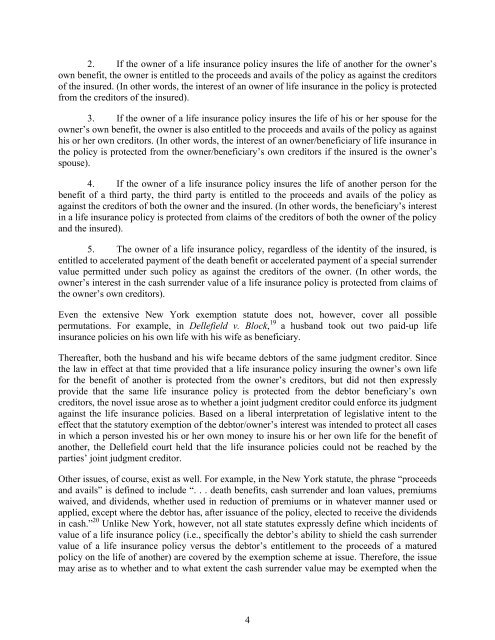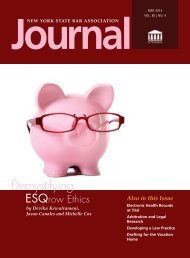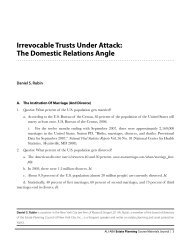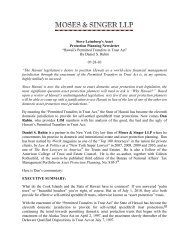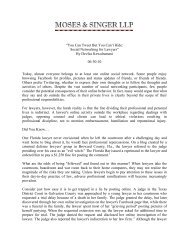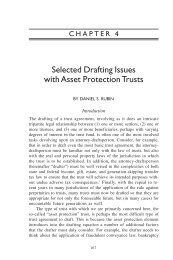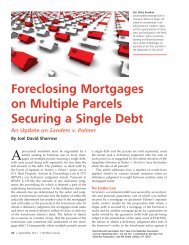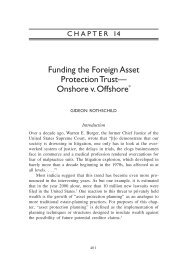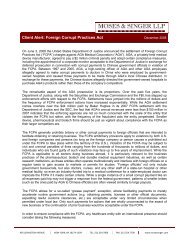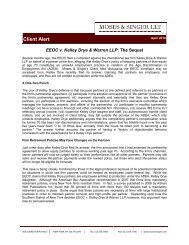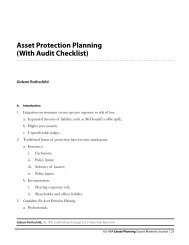Creditor Protection for Life Insurance and Annuities
Creditor Protection for Life Insurance and Annuities
Creditor Protection for Life Insurance and Annuities
Create successful ePaper yourself
Turn your PDF publications into a flip-book with our unique Google optimized e-Paper software.
2. If the owner of a life insurance policy insures the life of another <strong>for</strong> the owner’s<br />
own benefit, the owner is entitled to the proceeds <strong>and</strong> avails of the policy as against the creditors<br />
of the insured. (In other words, the interest of an owner of life insurance in the policy is protected<br />
from the creditors of the insured).<br />
3. If the owner of a life insurance policy insures the life of his or her spouse <strong>for</strong> the<br />
owner’s own benefit, the owner is also entitled to the proceeds <strong>and</strong> avails of the policy as against<br />
his or her own creditors. (In other words, the interest of an owner/beneficiary of life insurance in<br />
the policy is protected from the owner/beneficiary’s own creditors if the insured is the owner’s<br />
spouse).<br />
4. If the owner of a life insurance policy insures the life of another person <strong>for</strong> the<br />
benefit of a third party, the third party is entitled to the proceeds <strong>and</strong> avails of the policy as<br />
against the creditors of both the owner <strong>and</strong> the insured. (In other words, the beneficiary’s interest<br />
in a life insurance policy is protected from claims of the creditors of both the owner of the policy<br />
<strong>and</strong> the insured).<br />
5. The owner of a life insurance policy, regardless of the identity of the insured, is<br />
entitled to accelerated payment of the death benefit or accelerated payment of a special surrender<br />
value permitted under such policy as against the creditors of the owner. (In other words, the<br />
owner’s interest in the cash surrender value of a life insurance policy is protected from claims of<br />
the owner’s own creditors).<br />
Even the extensive New York exemption statute does not, however, cover all possible<br />
permutations. For example, in Dellefield v. Block, 19 a husb<strong>and</strong> took out two paid-up life<br />
insurance policies on his own life with his wife as beneficiary.<br />
Thereafter, both the husb<strong>and</strong> <strong>and</strong> his wife became debtors of the same judgment creditor. Since<br />
the law in effect at that time provided that a life insurance policy insuring the owner’s own life<br />
<strong>for</strong> the benefit of another is protected from the owner’s creditors, but did not then expressly<br />
provide that the same life insurance policy is protected from the debtor beneficiary’s own<br />
creditors, the novel issue arose as to whether a joint judgment creditor could en<strong>for</strong>ce its judgment<br />
against the life insurance policies. Based on a liberal interpretation of legislative intent to the<br />
effect that the statutory exemption of the debtor/owner’s interest was intended to protect all cases<br />
in which a person invested his or her own money to insure his or her own life <strong>for</strong> the benefit of<br />
another, the Dellefield court held that the life insurance policies could not be reached by the<br />
parties’ joint judgment creditor.<br />
Other issues, of course, exist as well. For example, in the New York statute, the phrase “proceeds<br />
<strong>and</strong> avails” is defined to include “. . . death benefits, cash surrender <strong>and</strong> loan values, premiums<br />
waived, <strong>and</strong> dividends, whether used in reduction of premiums or in whatever manner used or<br />
applied, except where the debtor has, after issuance of the policy, elected to receive the dividends<br />
in cash.” 20 Unlike New York, however, not all state statutes expressly define which incidents of<br />
value of a life insurance policy (i.e., specifically the debtor’s ability to shield the cash surrender<br />
value of a life insurance policy versus the debtor’s entitlement to the proceeds of a matured<br />
policy on the life of another) are covered by the exemption scheme at issue. There<strong>for</strong>e, the issue<br />
may arise as to whether <strong>and</strong> to what extent the cash surrender value may be exempted when the<br />
4


